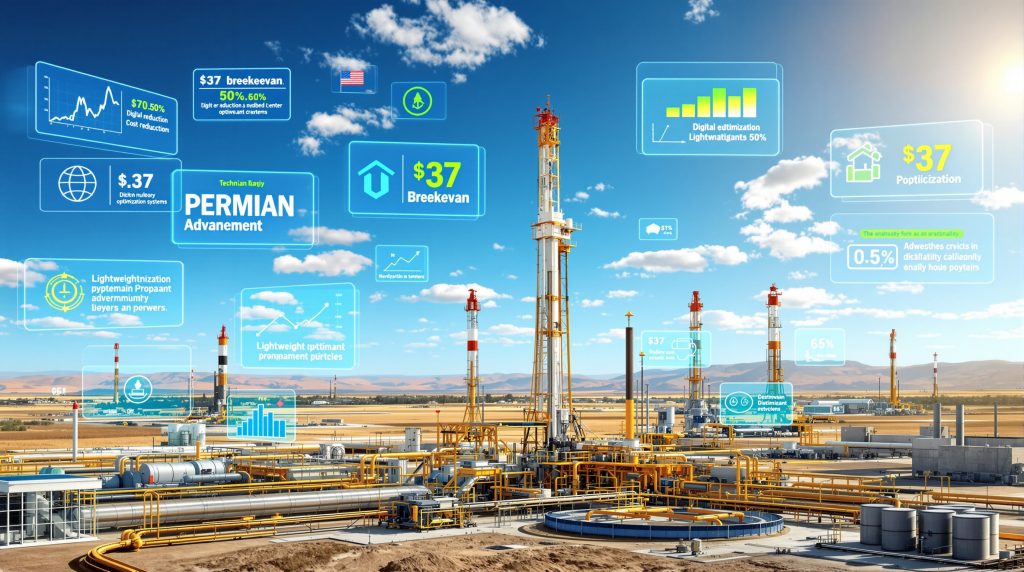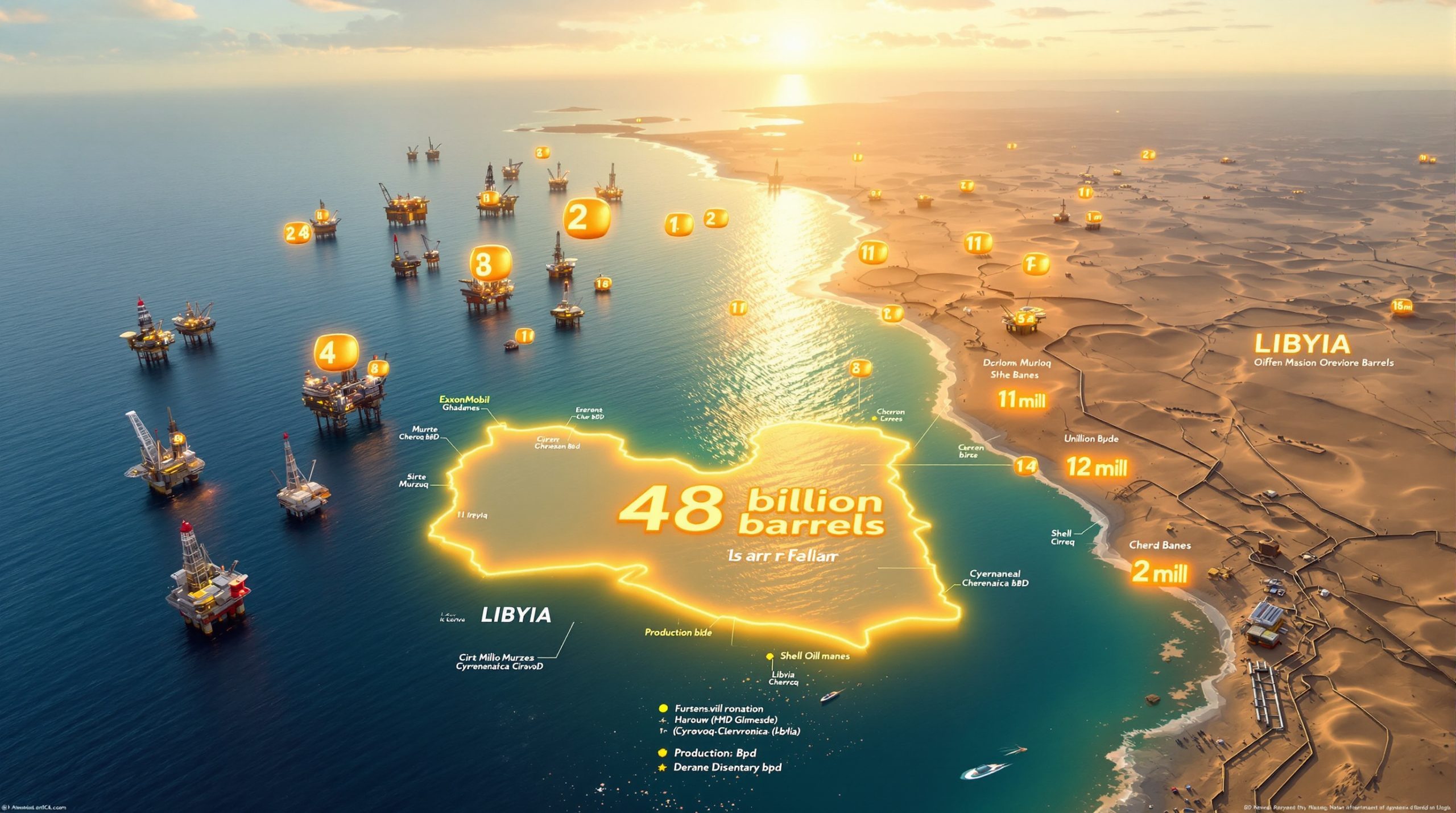What Technological Advances Are Driving Shale Efficiency?
Revolutionary drilling techniques and advanced completion methods have transformed U.S. shale production growth into a technology-driven sector capable of maintaining profitability despite market pressures. The integration of digital optimisation systems and lightweight proppant technology represents a fundamental shift from volume-focused to efficiency-driven operations.
Modern shale operators have achieved remarkable cost reductions through engineering innovation. Diamondback Energy exemplifies this transformation, reducing its break-even oil price to approximately $37 per barrel, representing an 8% decrease over two years. This improvement stems from faster drilling cycles and enhanced pumping methodologies that maximise recovery rates while minimising operational expenses.
Key Technology Implementation Areas:
• Advanced Hydraulic Fracturing: Lightweight proppant materials enhance well productivity by improving formation conductivity
• Drilling Speed Optimisation: Automated systems reduce drilling time while maintaining precision in well placement
• Digital Analytics Integration: Real-time data processing optimises completion designs and reduces non-productive time
• Power System Innovation: Microgrid technology reduces operational costs through localised energy generation
Exxon Mobil has pioneered the use of lightweight proppant technology in its advanced fracing methods, contributing to the company's 7% increase in 2025 output guidance to 1.6 million barrels of oil equivalent daily. Furthermore, these technological improvements demonstrate how engineering advances have enabled operators to maintain production growth while reducing capital intensity.
The transformation extends beyond individual well optimisation to encompass entire operational workflows. Coterra Energy's implementation of microgrid systems in West Texas specifically targets power cost reduction, enabling the company to plan 5% production growth while maintaining modest capital expenditures.
Modern shale operations have evolved from high-cost ventures requiring $70+ per barrel to sophisticated technology platforms profitable at $35-40 per barrel, fundamentally altering global energy market dynamics.
Technology Efficiency Improvements in Shale Operations
| Technology Area | Impact Metric | Production Enhancement |
|---|---|---|
| Drilling Optimisation | 15-20% time reduction | Higher well density potential |
| Completion Methods | 8-12% cost efficiency | Enhanced recovery rates |
| Digital Systems | Real-time optimisation | Maximised output per location |
| Power Infrastructure | Operational cost savings | Consistent production capability |
How Are Major Operators Adapting to $60 Oil Prices?
Leading shale producers have demonstrated remarkable adaptability to current oil pricing conditions through strategic operational adjustments and technological implementations. Rather than reducing output, major operators are leveraging efficiency gains to sustain and expand production while maintaining capital discipline.
Exxon Mobil's strategic response illustrates how large-scale operators capitalise on technological advantages. The company increased its 2025 production guidance by 100,000 barrels of oil equivalent daily, a volume exceeding many independent producers' total output. This expansion was achieved through advanced completion techniques rather than proportional capital increases, demonstrating improved operational efficiency.
Major Operator Production Strategies:
• Exxon Mobil: Implementing lightweight proppant technology across Permian operations
• Diamondback Energy: Achieving industry-leading $37 per barrel break-even costs through engineering optimisation
• Coterra Energy: Deploying microgrid power systems to reduce operational expenses
• Ovintiv: Maintaining production growth while preserving reduced capital expenditure levels
Diamondback Energy's approach exemplifies the engineering-focused strategy driving industry resilience. CEO Kaes Van't Hof emphasised the innovative capacity of American engineering, stating that operators will find methods to enhance profitability despite challenging market conditions. This philosophy has enabled the company to reduce break-even costs from approximately $40 to $37 per barrel over two years.
Coterra Energy's 2025-2026 strategy demonstrates how infrastructure innovation contributes to cost management. The company's microgrid installations in West Texas target specific operational expenses, enabling 5% production growth while reducing overall capital requirements. In addition, this approach represents a shift toward targeted efficiency improvements rather than broad-based spending increases.
Ovintiv's operational model showcases capital discipline within growth strategies. The company raised its 2025 guidance midpoint by less than 1% to 209,000 barrels per day while maintaining previously reduced spending plans, illustrating how technological improvements enable production increases without proportional cost escalation.
The industry transformation from volume-focused to efficiency-driven operations has created resilient business models capable of sustaining growth despite oil price volatility.
Operator Adaptation Strategies at $60 Oil
| Company | Break-Even Price | Production Target | Capital Approach |
|---|---|---|---|
| Diamondback Energy | $37/barrel | Growth maintained | Engineering efficiency |
| Coterra Energy | $38-42/barrel | 168,000 bpd (+5%) | Infrastructure optimisation |
| Ovintiv | $40-45/barrel | 209,000 bpd (+1%) | Capital discipline focus |
| Exxon Mobil | $35-40/barrel | 1.6 MMboed (+7%) | Scale advantage utilisation |
What Production Milestones Are Shale Companies Achieving?
U.S. shale production growth has reached unprecedented levels, with national oil output achieving 13.8 million barrels per day in August 2025 according to Energy Information Administration data. This record encompasses both onshore shale developments and offshore Gulf of Mexico projects, demonstrating the cumulative impact of technological advancement across multiple production segments.
Individual operator achievements highlight the scalability of efficiency improvements. Exxon Mobil's 100,000 barrel per day guidance increase alone represents production volumes exceeding entire independent companies' total output. This milestone illustrates how technological leadership translates into substantial production capabilities.
Record-Setting Production Achievements:
• National Output Peak: 13.8 million barrels per day reached in August 2025
• Exxon Mobil Growth: 7% production increase guidance to 1.6 million barrels of oil equivalent daily
• Industry Efficiency Gains: Break-even costs reduced from $70+ to $35-40 per barrel range
• Sustained Growth Trajectory: Multiple operators planning 5-7% annual production increases
The transformation in operational economics represents a fundamental shift in shale industry capabilities. Diamondback Energy's achievement of $37 per barrel break-even costs demonstrates how engineering innovations have created sustainable competitive advantages. This 8% improvement over two years reflects continuous optimisation rather than one-time technological gains.
Coterra Energy's production planning exemplifies the industry's capacity for measured growth. The company's target of approximately 168,000 barrels per day represents 5% annual growth achieved through operational efficiency rather than aggressive capital deployment. However, this approach balances production expansion with financial discipline.
Current Production Milestone Analysis
| Metric Category | Achievement Level | Industry Impact |
|---|---|---|
| National Production | 13.8 MMbpd peak | Global supply influence |
| Individual Operator Scale | 100,000+ bpd increases | Competitive differentiation |
| Cost Efficiency | $35-40 break-even range | Market resilience |
| Growth Sustainability | 5-7% annual increases | Long-term viability |
According to Macquarie Group analysis, one of the few commodity trading firms to correctly predict 2023's shale growth, production expansion will continue until oil prices decline into the low $50 per barrel range. This projection indicates substantial buffer between current pricing and production curtailment thresholds.
Featured insight: U.S. shale production growth continues despite $60 oil prices through technological advances that have reduced break-even costs to approximately $37 per barrel, enabling companies to maintain profitability while increasing output by 5-7% annually.
Why Are Shale Economics Defying Traditional Oil Price Sensitivity?
The fundamental transformation of shale economics stems from a systematic shift toward technology-driven cost management rather than price-dependent production decisions. Modern mine planning principles have influenced how operators create business models resilient to oil price fluctuations through engineering innovations that continuously reduce operational requirements.
Ben Hoff, global head of commodity strategy at Societe Generale SA, characterises this evolution as shale becoming a technology story focused on drilling advancement. According to his analysis, operators have maintained consistent barrel outputs while systematically addressing cost structures through technological implementation.
Technology Revolution Behind Cost Reductions:
• Engineering Innovation: Continuous improvement in drilling and completion techniques reducing time and material requirements
• Operational Streamlining: Faster drilling cycles and improved pumping methods enhancing productivity per dollar invested
• Infrastructure Development: Reduced transportation and processing costs through strategic asset positioning
• Scale Advantages: Larger operations achieving better unit economics through optimised resource utilisation
The industry's current price sensitivity threshold demonstrates this transformation's impact. Walt Chancellor, energy strategist at Macquarie Group, indicates that producers remain incentivised to grow at current $60 oil levels, with market signals requiring prices in the low $50 range to curtail expansion. This represents a fundamental shift from previous decades when $70+ oil was necessary for profitable operations.
Historical comparison reveals the magnitude of this economic transformation. Break-even requirements have declined from $70+ per barrel to the $35-40 range, representing approximately 50% cost reduction through technological advancement. Consequently, Diamondback Energy's specific achievement of $37 per barrel break-even costs exemplifies this industry-wide transformation.
Regional Break-Even Analysis Across Shale Basins
| Basin | Break-Even Range | Production Characteristics | Technology Maturity |
|---|---|---|---|
| Permian | $35-40/barrel | Highest capacity | Advanced implementation |
| Bakken | $40-45/barrel | Moderate output | Technology adoption |
| Eagle Ford | $38-43/barrel | Stable production | Established methods |
| Marcellus | $35-42/barrel | Gas-focused operations | Mature technology |
The resilience of current shale economics extends beyond individual operator efficiency to encompass market-wide competitive advantages. Exxon Mobil's leadership demonstrates how technological integration creates differentiation from competitors focused on reduced investments or harvest-mode operations. This strategic positioning enables sustained growth while maintaining profitability margins.
Modern shale operations have transformed from volume-focused to efficiency-driven enterprises, creating sustainable competitive advantages that extend beyond traditional price-driven decision making.
How Does Current Growth Compare to Historical Shale Expansion?
The evolution of U.S. shale production growth reveals three distinct phases, each characterised by different operational priorities and economic drivers. Understanding this progression provides context for current production resilience and future sustainability prospects.
Early Shale Era (2010-2015): High-Cost Expansion Phase
Initial shale development prioritised rapid volume growth with limited focus on operational efficiency. Break-even requirements exceeded $70 per barrel, and production decisions closely correlated with oil price movements. Capital intensity remained high as operators focused on resource delineation and initial commercial viability rather than optimised economics.
Consolidation Period (2016-2020): Efficiency Focus Development
Market pressures from the 2014-2016 oil price decline forced fundamental operational reassessment. Operators began implementing systematic cost reduction programs, improving drilling techniques, and optimising completion designs. This period established the foundation for current technological capabilities through necessity-driven innovation, incorporating lessons from industry evolution trends.
Modern Era (2021-Present): Technology-Driven Sustainable Growth
Current operations demonstrate the culmination of efficiency-focused development. Break-even costs have declined to the $35-40 range, enabling sustained production growth despite moderate oil pricing. For instance, operators maintain disciplined capital allocation while achieving consistent output increases through technological advancement.
Historical Growth Comparison Metrics
| Development Phase | Primary Focus | Break-Even Costs | Growth Characteristics |
|---|---|---|---|
| Early Era (2010-2015) | Volume expansion | $70+ per barrel | Price-sensitive scaling |
| Consolidation (2016-2020) | Efficiency improvement | $50-70 per barrel | Cost optimisation focus |
| Modern Era (2021-Present) | Technology integration | $35-40 per barrel | Sustainable growth model |
Contemporary growth patterns demonstrate enhanced market resilience compared to historical cycles. Current production increases of 5-7% annually occur within disciplined capital frameworks, contrasting with previous expansion cycles characterised by aggressive spending and high operational leverage.
The industry's response to $60 oil pricing illustrates this evolutionary transformation. Historical periods would have witnessed immediate production curtailments at similar price levels, while current operators maintain and expand output through technological advantages and operational efficiency.
What Are the Global Implications of Sustained U.S. Shale Growth?
Continued U.S. shale production growth creates significant market dynamics affecting global oil supply balances and producer strategies. The resilience demonstrated by American operators influences traditional producer responses and market pricing mechanisms worldwide.
Market Dynamics and Supply Chain Effects:
• OPEC Response Strategies: Traditional producers adjusting output policies to accommodate sustained U.S. growth
• Global Supply Balance: American production contributing to oversupply conditions affecting international pricing
• Price Pressure Points: Market analysts identifying critical thresholds where growth curtailment becomes necessary
• International Competitiveness: U.S. efficiency gains challenging conventional producer economics
Macquarie Group's analysis suggests that current market conditions appear oversupplied, requiring price signals in the low $50 per barrel range to curtail U.S. growth. This assessment indicates that American production expansion may continue influencing global supply dynamics until more significant price adjustments occur.
The sustained growth capability of U.S. shale operators challenges traditional market adjustment mechanisms. Historical patterns involved OPEC production management responding to demand fluctuations, while current dynamics require accounting for technologically-driven American production resilience.
Furthermore, international oil companies face strategic decisions regarding investment allocation between conventional projects and efficiency-focused operations. U.S. shale operators' demonstrated ability to maintain profitability at lower price points creates competitive pressure for global producers.
The transformation of U.S. shale economics represents a fundamental shift in global energy dynamics, where technological innovation has created sustainable competitive advantages affecting worldwide market balance.
Which Companies Are Leading the Efficiency Revolution?
Several operators exemplify the technological transformation driving sustained U.S. shale production growth despite challenging market conditions. These industry leaders demonstrate how strategic implementation of advanced techniques creates competitive advantages through data-driven operations.
Top Performers in Operational Excellence:
- Exxon Mobil: Leveraging scale advantages and integrated technology implementation
- Diamondback Energy: Achieving industry-leading cost structures through engineering optimisation
- Coterra Energy: Implementing innovative power solutions and infrastructure improvements
- Ovintiv: Optimising multi-basin operations with disciplined capital allocation
Exxon Mobil's leadership position demonstrates how scale enables technological advancement. The company's 7% production guidance increase to 1.6 million barrels of oil equivalent daily resulted from lightweight proppant implementation and advanced completion methods. CEO Darren Woods emphasised how these innovations differentiate Exxon from competitors pursuing reduced investment or harvest-mode strategies.
Diamondback Energy's efficiency model represents the engineering-focused approach driving industry transformation. The company's reduction in break-even costs from approximately $40 to $37 per barrel over two years reflects systematic operational optimisation across drilling and completion operations.
Case Study: Diamondback's Efficiency Implementation
• Cost Structure Improvement: Break-even reduction of 8% over two-year period
• Technology Integration: Advanced drilling and completion optimisation programs
• Strategic Location Focus: Concentration on highest-return drilling opportunities
• Continuous Optimisation: Ongoing operational improvement initiatives
Coterra Energy's approach illustrates infrastructure innovation contributing to operational efficiency. The company's microgrid installations in West Texas specifically target power cost reduction while enabling 5% production growth with modest capital expenditure increases.
Leading Company Performance Analysis
| Company | Efficiency Innovation | Break-Even Achievement | Growth Strategy |
|---|---|---|---|
| Exxon Mobil | Lightweight proppant technology | $35-40/barrel | Scale-driven expansion |
| Diamondberg Energy | Engineering optimisation | $37/barrel | Cost structure focus |
| Coterra Energy | Microgrid power systems | $38-42/barrel | Infrastructure efficiency |
| Ovintiv | Multi-basin optimisation | $40-45/barrel | Capital discipline model |
What Challenges Could Limit Future Shale Growth?
Despite current operational success, several factors may constrain long-term U.S. shale production growth. Understanding these potential limitations provides perspective on sustainability and investment decision-making.
Potential Growth Constraints:
• Resource Quality Decline: Premium drilling locations becoming increasingly scarce over time
• Infrastructure Limitations: Pipeline and processing capacity constraints affecting production growth
• Environmental Regulations: Increasing compliance costs and operational restrictions
• Market Saturation: Oversupply concerns potentially affecting investment allocation decisions
Resource depletion represents a fundamental long-term constraint as operators exhaust highest-quality drilling locations. While technological advancement continues improving recovery from lower-grade resources, the economic impact of declining resource quality may eventually affect growth trajectories.
Infrastructure development lags production growth in certain regions, creating bottlenecks for output expansion. Pipeline capacity, processing facilities, and transportation systems require substantial capital investment to support continued production increases.
Environmental regulatory developments introduce compliance costs and operational complexity. However, operators must allocate increasing resources to environmental management while maintaining economic efficiency, potentially affecting growth rates.
Growth Challenge Assessment Framework
| Challenge Category | Impact Timeline | Severity Level | Mitigation Approaches |
|---|---|---|---|
| Resource Quality Decline | 5-10 years | Moderate | Enhanced recovery technology |
| Regulatory Compliance | Ongoing | Variable | Innovation in environmental practices |
| Market Oversupply | 1-3 years | High | Production flexibility management |
| Infrastructure Constraints | 2-5 years | Moderate | Strategic capacity investments |
Market oversupply conditions create the most immediate growth constraint. Walt Chancellor of Macquarie Group indicates that sustained oversupply will eventually require market signals forcing U.S. production adjustments, likely occurring when prices decline into the low $50 per barrel range.
How Are Investment Patterns Changing in Shale Operations?
Capital allocation strategies within the shale sector have evolved significantly, reflecting the industry's transformation from volume-focused to efficiency-driven operations. Current investment patterns prioritise technological advancement and operational optimisation over aggressive expansion.
Capital Allocation Trends:
• Technology Investment: Increased spending on efficiency-enhancing systems and digital optimisation
• Consolidation Activity: Larger companies acquiring smaller operators to achieve scale advantages
• Infrastructure Development: Strategic investments in processing, transportation, and power systems
• ESG Compliance: Growing allocation toward environmental and social responsibility programs
Technology investment has become central to competitive strategy as operators recognise that operational efficiency determines long-term viability. Companies allocate increasing capital toward AI in drilling optimisation, completion design improvement, and digital analytics systems that enhance production per dollar invested.
Consolidation activity reflects the industry's maturation as larger operators acquire smaller companies to achieve scale advantages and operational synergies. Exxon Mobil's position as the largest Permian Basin operator exemplifies how scale enables technological implementation and cost optimisation.
Infrastructure investment focuses on addressing production bottlenecks and reducing operational costs. In addition, Coterra Energy's microgrid installations demonstrate targeted infrastructure spending designed to reduce long-term operational expenses while enabling production growth.
Investment Priority Evolution
| Investment Category | Current Allocation | Strategic Purpose | Expected Return |
|---|---|---|---|
| Drilling Technology | High priority | Efficiency improvement | Cost reduction |
| Digital Systems | Growing allocation | Optimisation enhancement | Production maximisation |
| Infrastructure | Strategic focus | Bottleneck resolution | Operational continuity |
| ESG Compliance | Increasing requirement | Regulatory alignment | Market access |
What Does the Future Hold for U.S. Shale Production Growth?
The trajectory of U.S. shale production growth depends on multiple factors including technological advancement, market conditions, and resource availability. Current trends suggest continued expansion capability despite evolving challenges.
Short-Term Outlook (2025-2027)
• Continued modest growth despite price pressures through technological efficiency
• Technology-driven operational improvements maintaining profitability margins
• Selective drilling concentration in highest-return locations
• Market share competition with traditional global producers
Near-term projections indicate sustained production increases as operators leverage accumulated technological advantages. The current $60 oil environment provides adequate margins above break-even thresholds, enabling selective growth in optimal locations through drilling program types optimisation.
Long-Term Projections (2028-2035)
• Potential production plateau as premium drilling locations become scarce
• Increased focus on enhanced recovery techniques and resource optimisation
• Integration with renewable energy systems for operational sustainability
• Evolution toward carbon-neutral operational frameworks
Long-term sustainability requires continued technological innovation to offset resource quality decline. Enhanced recovery techniques, improved completion designs, and operational integration with renewable energy systems may extend growth potential beyond current projections.
Market dynamics will significantly influence future growth patterns. Sustained oversupply conditions may eventually require production adjustments, while technological advancement continues reducing operational costs and improving competitive positioning.
Strategic insight: U.S. shale production growth represents a fundamental transformation in global energy dynamics, where technological innovation has created sustainable competitive advantages extending beyond traditional price-driven operational decisions.
Future Growth Scenario Analysis
| Time Horizon | Growth Expectation | Key Drivers | Limiting Factors |
|---|---|---|---|
| 2025-2027 | Continued expansion | Technological efficiency | Market pricing signals |
| 2028-2030 | Selective growth | Resource optimisation | Infrastructure constraints |
| 2031-2035 | Potential plateau | Enhanced recovery focus | Resource quality decline |
The industry's demonstrated resilience at current price levels indicates substantial adaptability to market conditions. However, long-term growth sustainability depends on continuous innovation and strategic resource management balancing production expansion with operational efficiency.
Consequently, investment in technology development and infrastructure optimisation will determine individual operator success within evolving market dynamics. Companies maintaining leadership in operational efficiency are positioned to sustain competitive advantages regardless of future market conditions.
Looking to Capitalise on Next-Generation Energy Opportunities?
Discovery Alert's proprietary Discovery IQ model delivers real-time notifications on significant ASX mineral discoveries, including critical materials driving the energy transition. Explore how major discoveries have delivered exceptional returns for early investors, then begin your 30-day free trial to position yourself ahead of the market.




